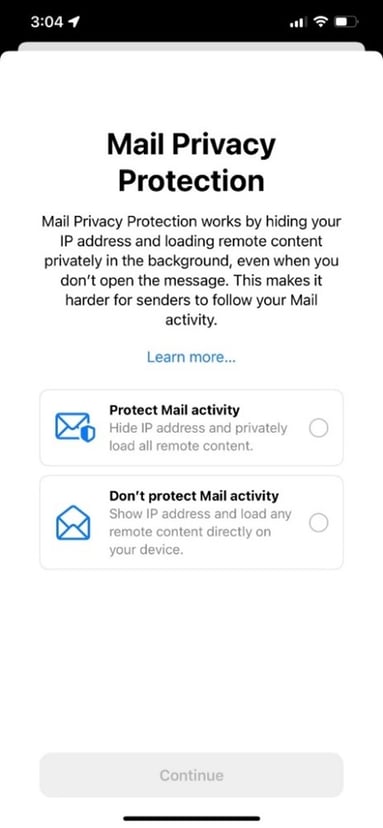Goodbye Open Rates? How the iOS15 Update Will Shake Up Your Marketing
When it comes to email marketing, open rates are a popular metric to track. Testing out that catchy subject line? Or working out what time of day your contacts are most active and likely to open your emails? Hello open rate. But with the recent release of the new Apple update, it might be time to rethink campaign metrics and reporting strategies.
What is the iOS15 update? The iOS15 release is here. Made up of a whole host of new features, the one most likely to change the way we do things is ‘Mail Privacy Protection’. So what is it, and how will it affect you and your marketing efforts?
What is Mail Privacy Protection?
If you’re an iOS user, you’ve probably already been asked if you want to opt-in to tracking on specific apps as a result of the iOS 14.5 update. But with this new release, things will go a step further and users of the Apple Mail app on iPhone iOS 15, iPad iOS 15 and macOS Monterey devices will now have the option to opt-out of email tracking – essentially, they can mask their IP address and open data. Although this won’t be turned on by default, it’s become clear that the prominent notification will be hard to miss. Here’s what it looks like:
 Source: Ryan Jones via Twitter
Source: Ryan Jones via Twitter
Presented in this way, it seems safe to say that most people will choose to protect their data and opt-out of email tracking. Once opted-out, your open rates will actually be inflated. This is because Apple will pre-load emails and register each one as an 'open' rather than loading tracking pixels as and when recipients open an email.
So, what should we do now that we can’t rely on open rates?
There’s no doubt that this new update might come as a bit of a blow to anyone who uses open rates in their campaign optimisation which, let’s be honest, is most of us. With open rates becoming skewed for contacts using the Mail app to read their emails, we will no longer be able to rely on this metric and will have to look further afield. But don’t panic! This will not be the end of email marketing or destroy your campaigns. So how can we turn this around and view these changes as a positive?
1. Move Away from Opens
Let’s face it, open rates aren’t the most reliable metric. This could be the push we all need to shift our focus from this so-called ‘vanity metric’ to something a bit more substantial – at the end of the day, conversions are key. Pivoting to a focus on clickthrough rates, leads and responses will focus your marketing efforts on what’s important.
Are you sending emails to your members detailing all the exciting new classes you’re about to launch? Taking a closer look at your email recipients who click through to read more or book a space could be useful in helping you to nail down the demographic who are interested in a particular class. Or it could help you predict how popular the class will be which will help with timetabling or determining where to focus your next marketing push.
2. Focus on Email Content
Before this iOS bombshell dropped, you might have been running A/B tests to determine the best subject lines to use to grab your members’ and prospective customers’ attention. Now it’s time to switch up your email content instead – try using a mixture of text-based emails, and others with multiple images to determine which receive the most clicks. You can then make educated guesses on what style grabs your readers' attention and encourages maximum clicking.
3. Nail Your CTAs
It looks like clickthrough rates will be the new opens. So it's more important than ever to create engaging and effective CTAs. Make it clear where you want your readers to click at the end of every email and make it too tempting to resist!
4. Get Creative
But there are a few situations where it will be hard to replace the trusty open rate. For example, retention and re-engagement marketing often relies on tracking opens – eg. sending a follow-up email after a week if someone hasn’t opened the first email. Or cleaning your database of contacts who haven’t opened the last, say, 12 emails from you.
Segmentation based on engagement will also be affected. If you normally send different content depending on how often your contacts open your emails, you might need to have a rethink. Relying on click-throughs as an engagement measure also comes with its own precautions eg. if you’re viewing click-throughs as a measure of who is reading your emails, you might unintentionally stop sending to those who are reading your emails but aren’t clicking through.
Instead of basing engagement solely on clicks, you might like to look at email clicks in combination with other metrics such as website visits, account activity, mobile app activity or social media engagement to determine your most and least engaged customers.
.png?width=675&name=Blog%20Banners%20(2).png)
What should we take away from all of this?
Instead of being all doom and gloom about this, we should view these upcoming changes as an opportunity to revamp our email marketing strategies. If you’re not already doing so, it’s time to shift your focus to clicks and conversions (arguably a much more reliable metric to track anyway!) And although a move away from open rates might be a bit of a pain and take some getting used to, it’s nothing you can’t handle! And who knows? Maybe a shakeup to your marketing tactics could lead to even more members flooding into your centres. Watch this space.
Share this
You May Also Like
These Related Stories

Brushing Up Our Workspace: A Tale of Transformation & Community Connection

New Year, New Marketing Resolutions: Prepare for the Gym Rush!
.png)


No Comments Yet
Let us know what you think